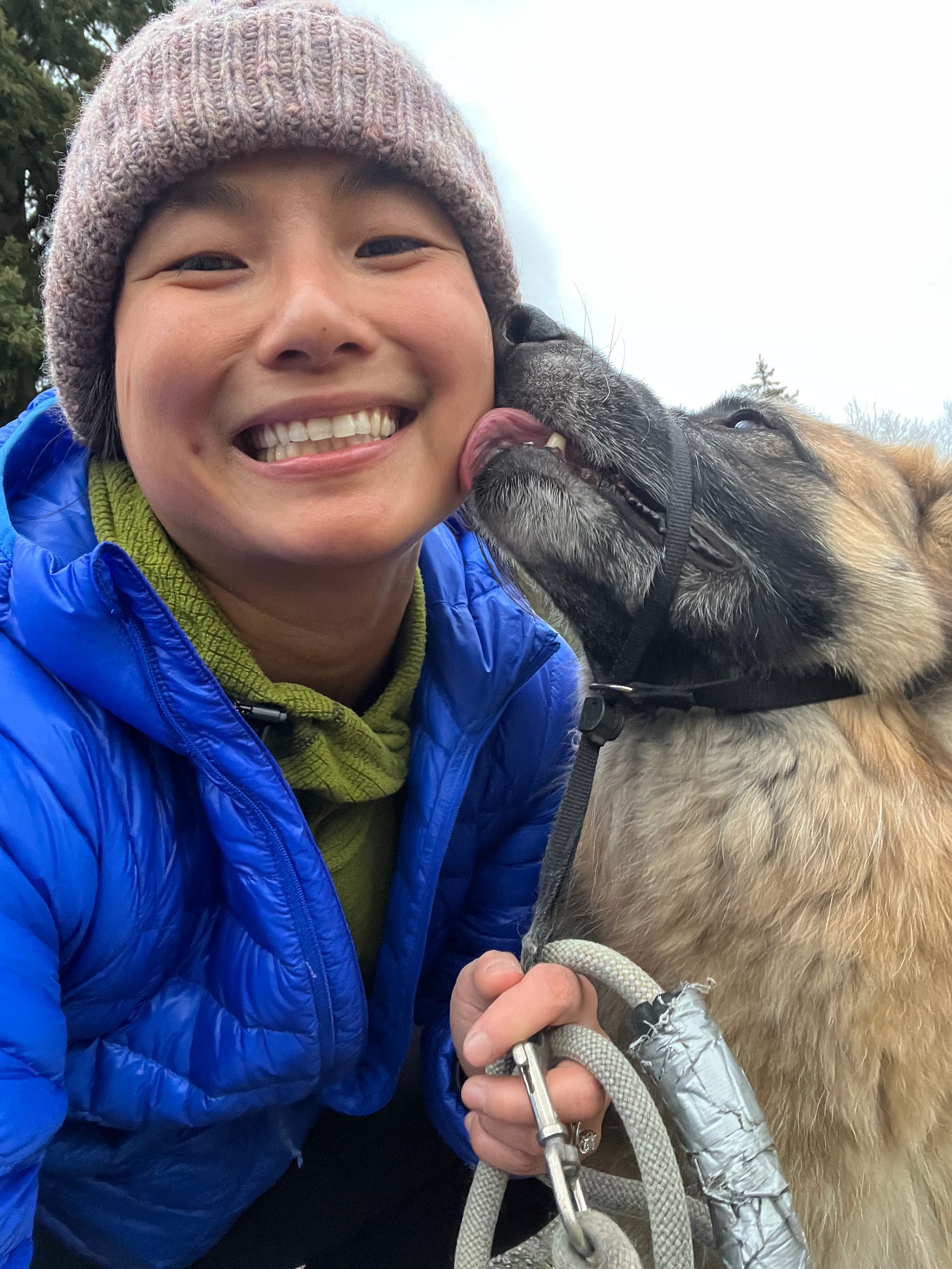Taming reactivity
What living with a reactive dog taught me about managing my own emotions under Trump 2.0
It was early summer 2019, when my then-boyfriend-now-husband and I walked into the Seattle Animal Shelter. Yes, we were looking for a dog, but we weren’t serious. We told ourselves we were “just window shopping.” If we saw a dog that fit what we were looking for, we’d strongly consider it. (He was looking for a dog that was large and cuddly; I wanted it to be smart and to turn heads when I was out walking it.)
As we walked through the kennels, one dog— large enough to be a wolf, but seemed at first blush to be breed ambiguous—immediately jumped up to the window when I approached. She was covered in her own poop, mane untamed. And she was adorable.
Outside, the shelter staff told us about this dog, named June. At the time, she was about nine months old. She was breed ambiguous to me because she was a long-haired German Shepherd. It turns out that the long-hair trait is recessive, and long-haired GSDs are less desirable as far as working dogs go because of their excessive grooming needs. June came into the shelter in terrible shape with a broken leg. Her previous owners, allegedly breeders, had abused her: she was not properly socialized in the critical, small window of time that dogs have to become less fearful of the world. June had never been socialized to other dogs, cats, other animals, and as a result, is highly reactive towards them. So when she barked and growled and snarled and lunged at another dog as it walked past, it masked how batshit terrified she was inside.
We brought her home nevertheless. How could you resist that face????
When we first got her, we still lived in Seattle proper. Which meant we had to try and make her suitable for city living. We hired trainers—yes, multiple!— some of whom with opposing training philosophies, to see what would work best. We thought she was still young enough that even though we missed her critical socialization period, that we could still try and make her less reactive through slow exposure. That didn’t work at all. In fact, it backfired.
At first, taming her reactivity was challenging. I tried to tamp down early signs of reactivity with a small buzz on her electric collar. I tried to distract her with blocks of cheese if another dog was on the other side of the street. None of this really worked.
This isn’t a story about how I got rid of June’s reactivity. Because any owner of a reactive dog will know that it isn’t possible. What I learned, however, was to change her environment so she would be less reactive.
Over the years, I learned that June’s visual recognition of another dog jumpstarts her reactivity. On walks, I physically stand between her and any possible trigger. If I see a dog 100 meters up the way, I’ll put her out of sight, get her to sit and shower her with affection until the ‘threat’ has passed. We avoid houses where owners let their dogs run free in their fenced yards. I do the best I can to create a psychologically safer, more emotionally regulated living experience for her, because I know it’s possible with subtle changes in my own behavior.
Reactivity for dogs and humans both stem back to our fight-or-flight impulses. So, as Trump took office last month, I wondered: what if I tried what I did for June, on myself?
During Trump’s first term, I was still on Twitter, and was constantly flooded by a deluge of terrible, very bad news. My emotions were at the whims of not just the news itself, but also the speed at which it came to me. Being on Twitter constantly also gave me this false sense of urgency, that if this tweet I wrote went viral, I had to immediately confront it, otherwise I would get cancelled or… whatever. People who spent time around me then know that I would literally interrupt a conversation because there was something on Twitter I had to respond to “real quick.”
This time, though, I wanted to choose myself. I not only wanted to be in control of the information I got, but I wanted to be in control of the emotions I felt. I didn’t want any of this to be at the whims of other algorithms. I wanted to choose my own sanity. I wanted to reserve my rage for things that warranted it most. I wanted to feel emotionally regulated so I could have emotional bandwidth for the people in my life who needed it.
I knew that in order to achieve this, I had to alter my own environment. Similar to how I put physical obstructions between June and other dogs, I did the same for things that I knew would trigger me. I had already deleted Twitter a few months after Elon acquired it. I signed up for BlueSky but conveniently forgot my password, which meant I could only access it on my computer. I had all news and email notifications turned off. News would no longer be something I’d have to opt out of, but something I’d have to opt in for. And I knew that really big news would find me.
I’m not going to list every bad thing that’s happened since Jan 20, 2025. Because it’s a lot, and if I had to guess, that’s not why you’re reading this. But I will say: creating impediments between me and the news and the speed of news doesn’t mean I’m burying my head in the sand. I am keeping track of all these things at my own human pace, because they affect people I care about and places I love. But I’m not outraged, scared, angry at the same rate I would be if I didn’t have those stopgaps in place. I can stop, pause, find ways to self-soothe, give myself a treat, go outside—do anything—besides feeling like I have to bark incessantly.


